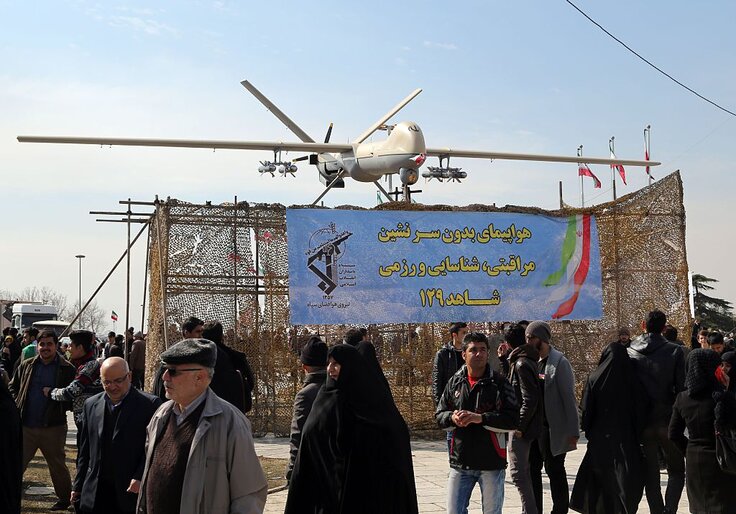Texas senator investigating lapse in U.S. sanctions enabling Tehran’s proxies to fund war on Israel

The suicide drones used by Iran’s Houthi militants to conduct a deadly and unprecedented attack on Tel Aviv last week were constructed primarily with American components, highlighting severe gaps in U.S. sanctions on Tehran, according to Sen. Ted Cruz (R., Texas).
Yemen’s Houthi militants, who are funded and directed by Iran, significantly escalated their attacks on Israel last week when they launched a long-range drone strike on Israel’s second largest city, killing one person and wounding several others. The advanced military equipment was supplied by Iran, constructed using American parts, and funded by more than $100 billion in sanctions relief that has been granted to the hardline regime during President Joe Biden’s tenure in office, Cruz said in an investigatory letter sent to the White House on Monday.
“The construction of the drones is enabled by the regime’s access to American components, and indeed the drones are built almost entirely from components produced by U.S. companies,” Cruz wrote before asking White House officials to immediately brief Congress on the matter.
“Military production of the drones is financed by funds available to the Iranian regime, including roughly 100 billion dollars that the Biden administration has allowed to flow to the Ayatollah.”
The letter comes just days after the Biden administration renewed a sanctions waiver that unlocks upwards of $10 billion for Iran via cash payment from Iraq. These funds, Cruz and other Republicans say, are funding Iran’s production of deadly drones, which have been exported to terror groups across the region, as well as Russia for use in its war on Ukraine. Iran has been accessing key American electronic components for years, allowing it to build up a fleet of advanced drones that comprise about 80 percent of its total arsenal, according to congressional sources briefed on the issue.
“These drones are made almost entirely of American components, including ones cannibalized from other machines or transferred through third or fourth-party distributors using convoluted routes to move tiny electronics,” Cruz said. “U.S. export and trade restrictions are aimed in part to prevent the acquisition of such components by rogue regimes such as Iran; their failure suggests either a lack of will or ability by the Biden administration.”
U.S. officials claim they are “working to restrict access to such components” but have provided little evidence to show the efforts are effective.
Cruz, as a member of the Senate Committee on Commerce, Science, and Transportation, is requesting that Biden administration officials come before Congress to explain their failure to stem the flow of American components to Iran.
The issue has taken on renewed significance in the wake of the Houthi’s strike on Tel Aviv, which marked a significant escalation and showed that Tehran’s regional proxy groups are willing to use the advanced arms they are receiving from Iran. It is being seen as a warning sign that other regional terror groups—including Hezbollah in Lebanon, militias in Iraq, and Hamas in the Gaza Strip—could employ similar weapons against Israel and U.S. positions in the region.
“The Iranian regime has engaged in the use and mass proliferation of loitering munitions—so-called suicide drones—by its own forces, Russia, and its terrorist proxies across the Middle East for decades,” Cruz wrote in his Monday letter. “Those munitions are being used to attack U.S. servicemembers and our allies, including Israel and Ukraine, and more broadly to undermine American national security interests.”
The White House has long been aware of the issue and attempted to counter it by forming an “expansive task force” in 2022. The task force, which is overseen by the White House National Security Council, was supposed to determine how American-made components were making their way to Tehran—and probe how those components were used to build drones used by Russia to attack Ukraine.
Since the task force’s formation, however, “there has not been a single published update, report, or announcement,” according to Cruz.
The senator is now asking the White House to “detail the task force’s activities to date” and disclose whether it has “engaged American companies whose components have been found in Iranian-made drones.” Cruz also wants to know if the task force has “requested or compiled a list of manufacturers or distributors used by American companies whose products have been found in Iranian drones.”
The United States, meanwhile, continues to provide Iran with critical sanctions relief, cash that critics say is funding the hardline regime’s terrorism enterprise.
Late last week, the State Department granted Iraq a sanctions waiver that permits it to move around $10 billion to Iran as part of backlogged electricity payments. While the administration claims this money can only be used for humanitarian purchases, Republican critics argue that money is fungible, and that the cash freed up through the waiver enables Iran to continue spending cash on weapons manufacturing.
Illicit Iranian oil sales have also surged to around $90 billion under the Biden administration due to the lax enforcement of sanctions and other measures.
Original News Source – Washington Free Beacon
Running For Office? Conservative Campaign Management – Election Day Strategies!
